MGT602 Business Decision Analytics - System Thinking: Netflix Case
VerifiedAdded on 2023/04/08
|8
|1318
|343
Report
AI Summary
This report employs system thinking, specifically the rich picture approach and CATWOE technique, to analyze the problem of policy changes at Netflix concerning job security, uninformed terminations, and compensations. It highlights the interconnectedness of various stakeholders and their perspectives on organizational processes, emphasizing the importance of a holistic view in addressing business challenges. The CATWOE analysis identifies customers, actors, transformation processes, worldviews, owners, and environmental constraints related to Netflix's policy changes. The report concludes with recommendations for managing policy changes to minimize negative impacts on stakeholders, suggesting proactive communication, employee training, and diversification of services to ensure organizational sustainability. Desklib provides access to similar solved assignments and past papers for students.
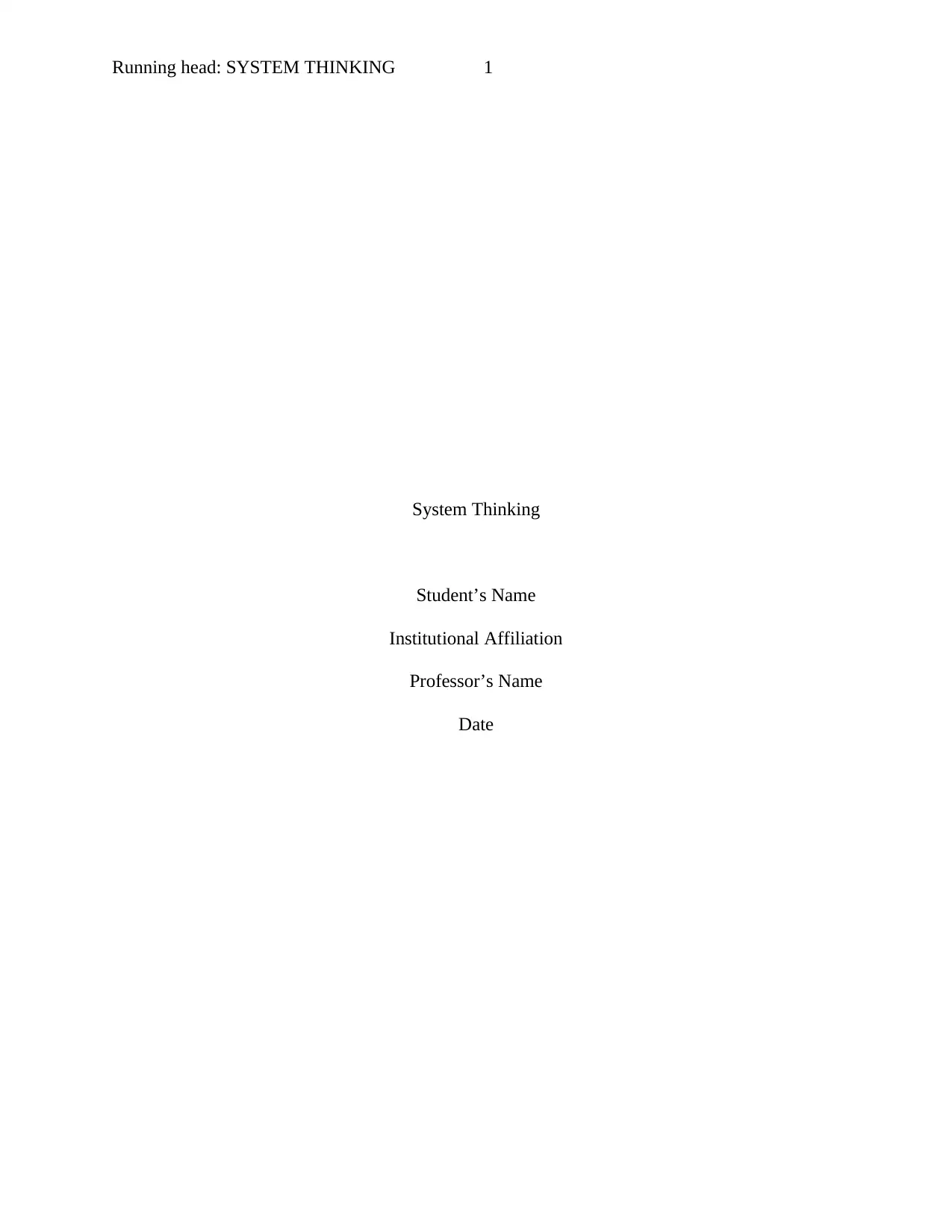
Running head: SYSTEM THINKING 1
System Thinking
Student’s Name
Institutional Affiliation
Professor’s Name
Date
System Thinking
Student’s Name
Institutional Affiliation
Professor’s Name
Date
Paraphrase This Document
Need a fresh take? Get an instant paraphrase of this document with our AI Paraphraser
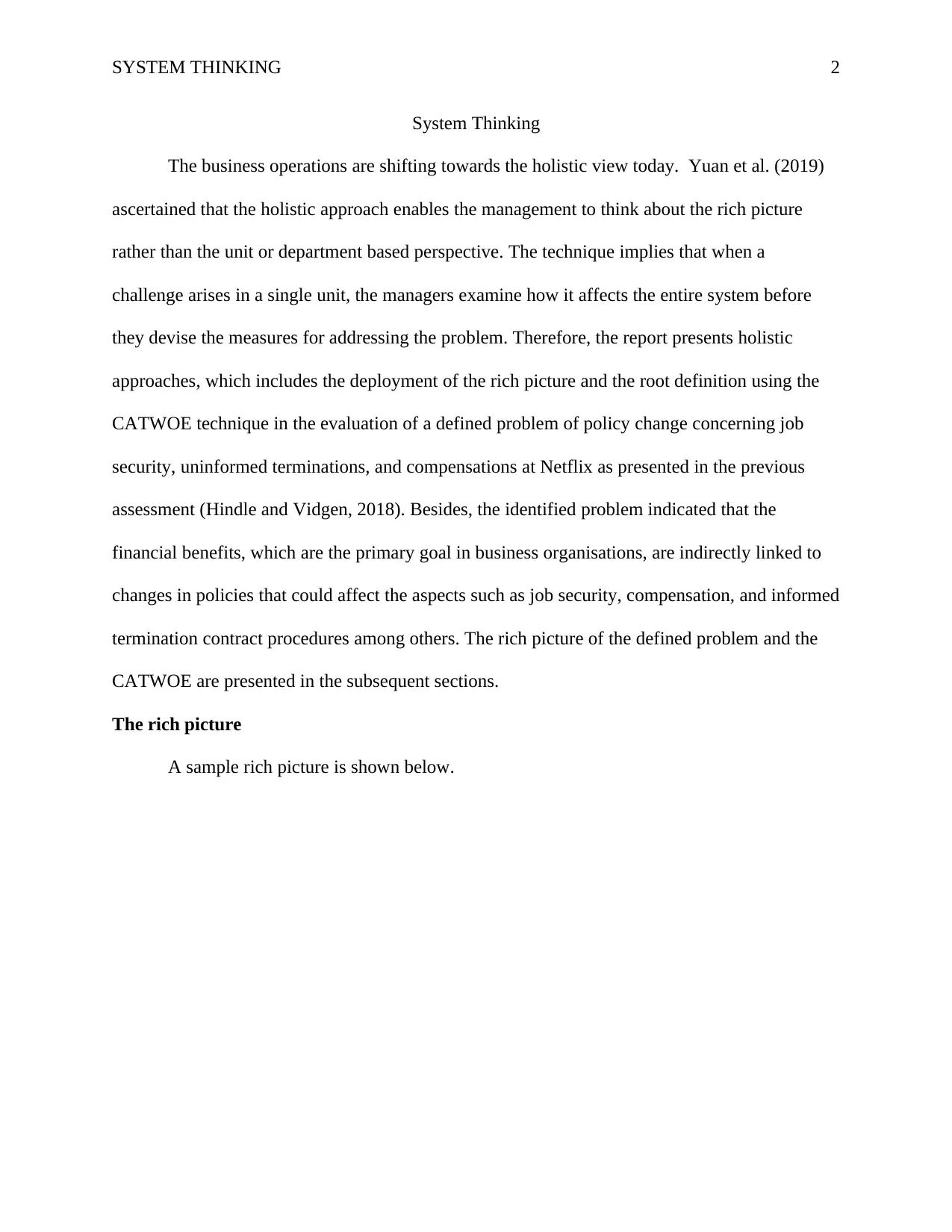
SYSTEM THINKING 2
System Thinking
The business operations are shifting towards the holistic view today. Yuan et al. (2019)
ascertained that the holistic approach enables the management to think about the rich picture
rather than the unit or department based perspective. The technique implies that when a
challenge arises in a single unit, the managers examine how it affects the entire system before
they devise the measures for addressing the problem. Therefore, the report presents holistic
approaches, which includes the deployment of the rich picture and the root definition using the
CATWOE technique in the evaluation of a defined problem of policy change concerning job
security, uninformed terminations, and compensations at Netflix as presented in the previous
assessment (Hindle and Vidgen, 2018). Besides, the identified problem indicated that the
financial benefits, which are the primary goal in business organisations, are indirectly linked to
changes in policies that could affect the aspects such as job security, compensation, and informed
termination contract procedures among others. The rich picture of the defined problem and the
CATWOE are presented in the subsequent sections.
The rich picture
A sample rich picture is shown below.
System Thinking
The business operations are shifting towards the holistic view today. Yuan et al. (2019)
ascertained that the holistic approach enables the management to think about the rich picture
rather than the unit or department based perspective. The technique implies that when a
challenge arises in a single unit, the managers examine how it affects the entire system before
they devise the measures for addressing the problem. Therefore, the report presents holistic
approaches, which includes the deployment of the rich picture and the root definition using the
CATWOE technique in the evaluation of a defined problem of policy change concerning job
security, uninformed terminations, and compensations at Netflix as presented in the previous
assessment (Hindle and Vidgen, 2018). Besides, the identified problem indicated that the
financial benefits, which are the primary goal in business organisations, are indirectly linked to
changes in policies that could affect the aspects such as job security, compensation, and informed
termination contract procedures among others. The rich picture of the defined problem and the
CATWOE are presented in the subsequent sections.
The rich picture
A sample rich picture is shown below.
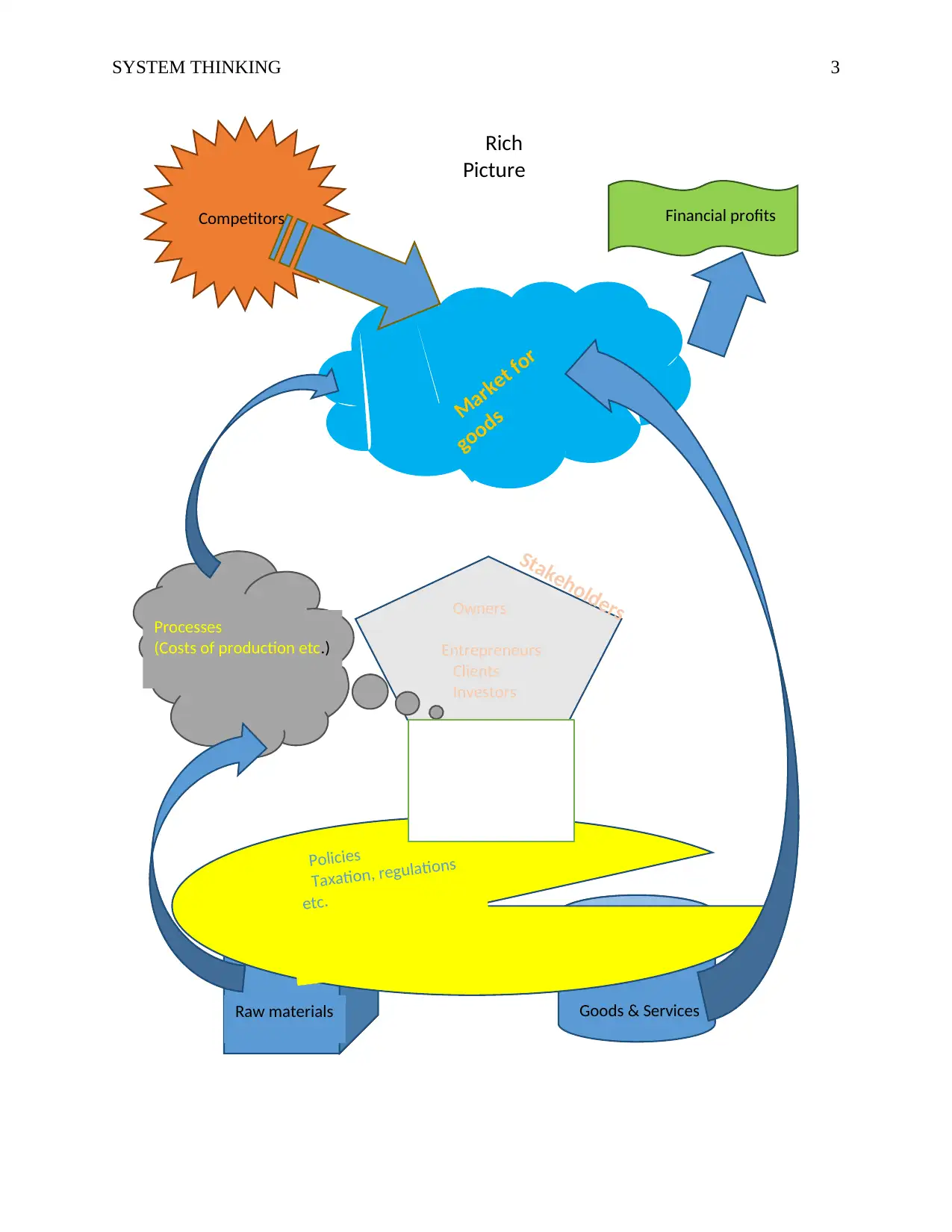
Market for
goods
Rich
Picture
Financial profitsCompetitors
Stakeholders
Policies
Taxation, regulations
etc.
Owners
Entrepreneurs
Clients
Investors
Raw materials Goods & Services
Processes
(Costs of production etc.)
SYSTEM THINKING 3
goods
Rich
Picture
Financial profitsCompetitors
Stakeholders
Policies
Taxation, regulations
etc.
Owners
Entrepreneurs
Clients
Investors
Raw materials Goods & Services
Processes
(Costs of production etc.)
SYSTEM THINKING 3
⊘ This is a preview!⊘
Do you want full access?
Subscribe today to unlock all pages.

Trusted by 1+ million students worldwide
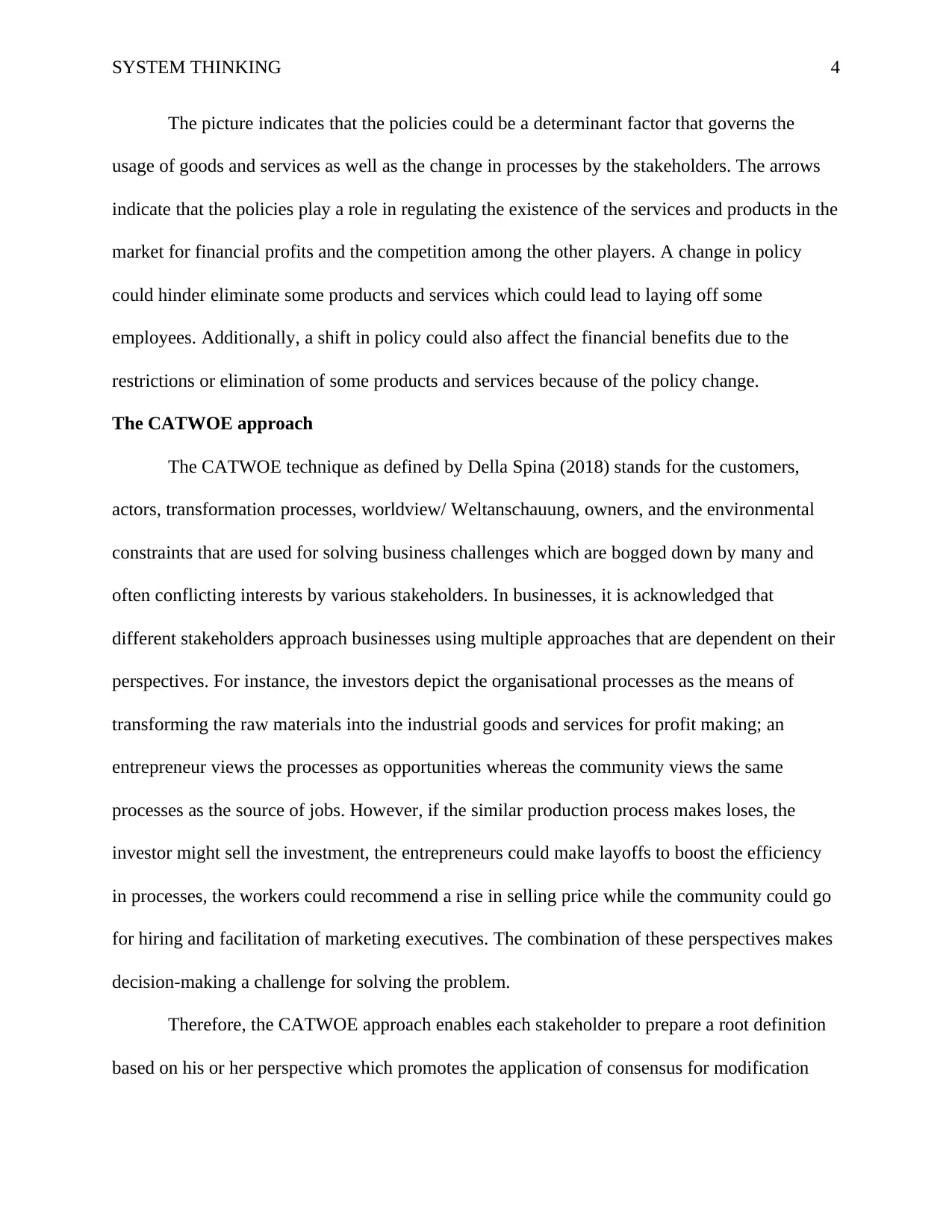
SYSTEM THINKING 4
The picture indicates that the policies could be a determinant factor that governs the
usage of goods and services as well as the change in processes by the stakeholders. The arrows
indicate that the policies play a role in regulating the existence of the services and products in the
market for financial profits and the competition among the other players. A change in policy
could hinder eliminate some products and services which could lead to laying off some
employees. Additionally, a shift in policy could also affect the financial benefits due to the
restrictions or elimination of some products and services because of the policy change.
The CATWOE approach
The CATWOE technique as defined by Della Spina (2018) stands for the customers,
actors, transformation processes, worldview/ Weltanschauung, owners, and the environmental
constraints that are used for solving business challenges which are bogged down by many and
often conflicting interests by various stakeholders. In businesses, it is acknowledged that
different stakeholders approach businesses using multiple approaches that are dependent on their
perspectives. For instance, the investors depict the organisational processes as the means of
transforming the raw materials into the industrial goods and services for profit making; an
entrepreneur views the processes as opportunities whereas the community views the same
processes as the source of jobs. However, if the similar production process makes loses, the
investor might sell the investment, the entrepreneurs could make layoffs to boost the efficiency
in processes, the workers could recommend a rise in selling price while the community could go
for hiring and facilitation of marketing executives. The combination of these perspectives makes
decision-making a challenge for solving the problem.
Therefore, the CATWOE approach enables each stakeholder to prepare a root definition
based on his or her perspective which promotes the application of consensus for modification
The picture indicates that the policies could be a determinant factor that governs the
usage of goods and services as well as the change in processes by the stakeholders. The arrows
indicate that the policies play a role in regulating the existence of the services and products in the
market for financial profits and the competition among the other players. A change in policy
could hinder eliminate some products and services which could lead to laying off some
employees. Additionally, a shift in policy could also affect the financial benefits due to the
restrictions or elimination of some products and services because of the policy change.
The CATWOE approach
The CATWOE technique as defined by Della Spina (2018) stands for the customers,
actors, transformation processes, worldview/ Weltanschauung, owners, and the environmental
constraints that are used for solving business challenges which are bogged down by many and
often conflicting interests by various stakeholders. In businesses, it is acknowledged that
different stakeholders approach businesses using multiple approaches that are dependent on their
perspectives. For instance, the investors depict the organisational processes as the means of
transforming the raw materials into the industrial goods and services for profit making; an
entrepreneur views the processes as opportunities whereas the community views the same
processes as the source of jobs. However, if the similar production process makes loses, the
investor might sell the investment, the entrepreneurs could make layoffs to boost the efficiency
in processes, the workers could recommend a rise in selling price while the community could go
for hiring and facilitation of marketing executives. The combination of these perspectives makes
decision-making a challenge for solving the problem.
Therefore, the CATWOE approach enables each stakeholder to prepare a root definition
based on his or her perspective which promotes the application of consensus for modification
Paraphrase This Document
Need a fresh take? Get an instant paraphrase of this document with our AI Paraphraser
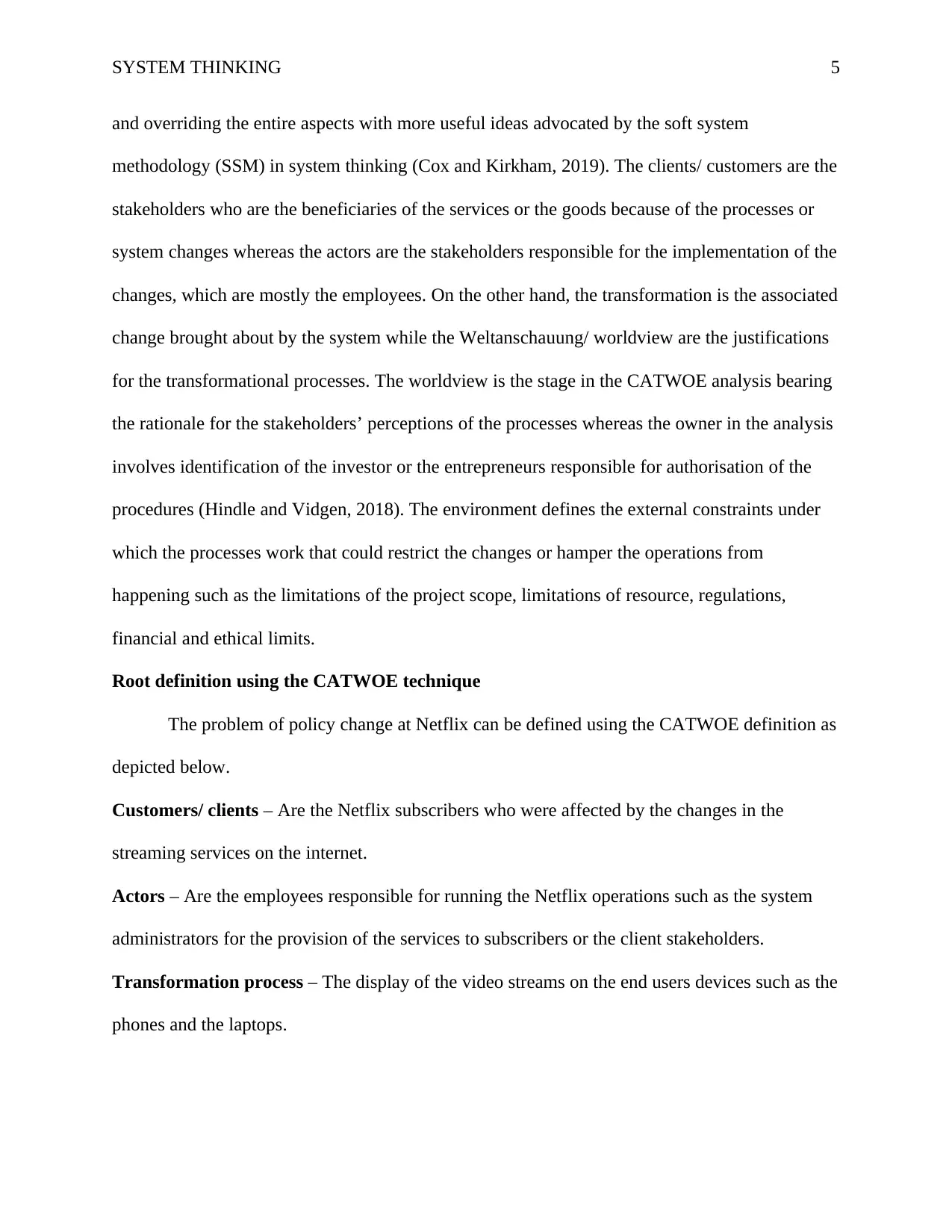
SYSTEM THINKING 5
and overriding the entire aspects with more useful ideas advocated by the soft system
methodology (SSM) in system thinking (Cox and Kirkham, 2019). The clients/ customers are the
stakeholders who are the beneficiaries of the services or the goods because of the processes or
system changes whereas the actors are the stakeholders responsible for the implementation of the
changes, which are mostly the employees. On the other hand, the transformation is the associated
change brought about by the system while the Weltanschauung/ worldview are the justifications
for the transformational processes. The worldview is the stage in the CATWOE analysis bearing
the rationale for the stakeholders’ perceptions of the processes whereas the owner in the analysis
involves identification of the investor or the entrepreneurs responsible for authorisation of the
procedures (Hindle and Vidgen, 2018). The environment defines the external constraints under
which the processes work that could restrict the changes or hamper the operations from
happening such as the limitations of the project scope, limitations of resource, regulations,
financial and ethical limits.
Root definition using the CATWOE technique
The problem of policy change at Netflix can be defined using the CATWOE definition as
depicted below.
Customers/ clients – Are the Netflix subscribers who were affected by the changes in the
streaming services on the internet.
Actors – Are the employees responsible for running the Netflix operations such as the system
administrators for the provision of the services to subscribers or the client stakeholders.
Transformation process – The display of the video streams on the end users devices such as the
phones and the laptops.
and overriding the entire aspects with more useful ideas advocated by the soft system
methodology (SSM) in system thinking (Cox and Kirkham, 2019). The clients/ customers are the
stakeholders who are the beneficiaries of the services or the goods because of the processes or
system changes whereas the actors are the stakeholders responsible for the implementation of the
changes, which are mostly the employees. On the other hand, the transformation is the associated
change brought about by the system while the Weltanschauung/ worldview are the justifications
for the transformational processes. The worldview is the stage in the CATWOE analysis bearing
the rationale for the stakeholders’ perceptions of the processes whereas the owner in the analysis
involves identification of the investor or the entrepreneurs responsible for authorisation of the
procedures (Hindle and Vidgen, 2018). The environment defines the external constraints under
which the processes work that could restrict the changes or hamper the operations from
happening such as the limitations of the project scope, limitations of resource, regulations,
financial and ethical limits.
Root definition using the CATWOE technique
The problem of policy change at Netflix can be defined using the CATWOE definition as
depicted below.
Customers/ clients – Are the Netflix subscribers who were affected by the changes in the
streaming services on the internet.
Actors – Are the employees responsible for running the Netflix operations such as the system
administrators for the provision of the services to subscribers or the client stakeholders.
Transformation process – The display of the video streams on the end users devices such as the
phones and the laptops.
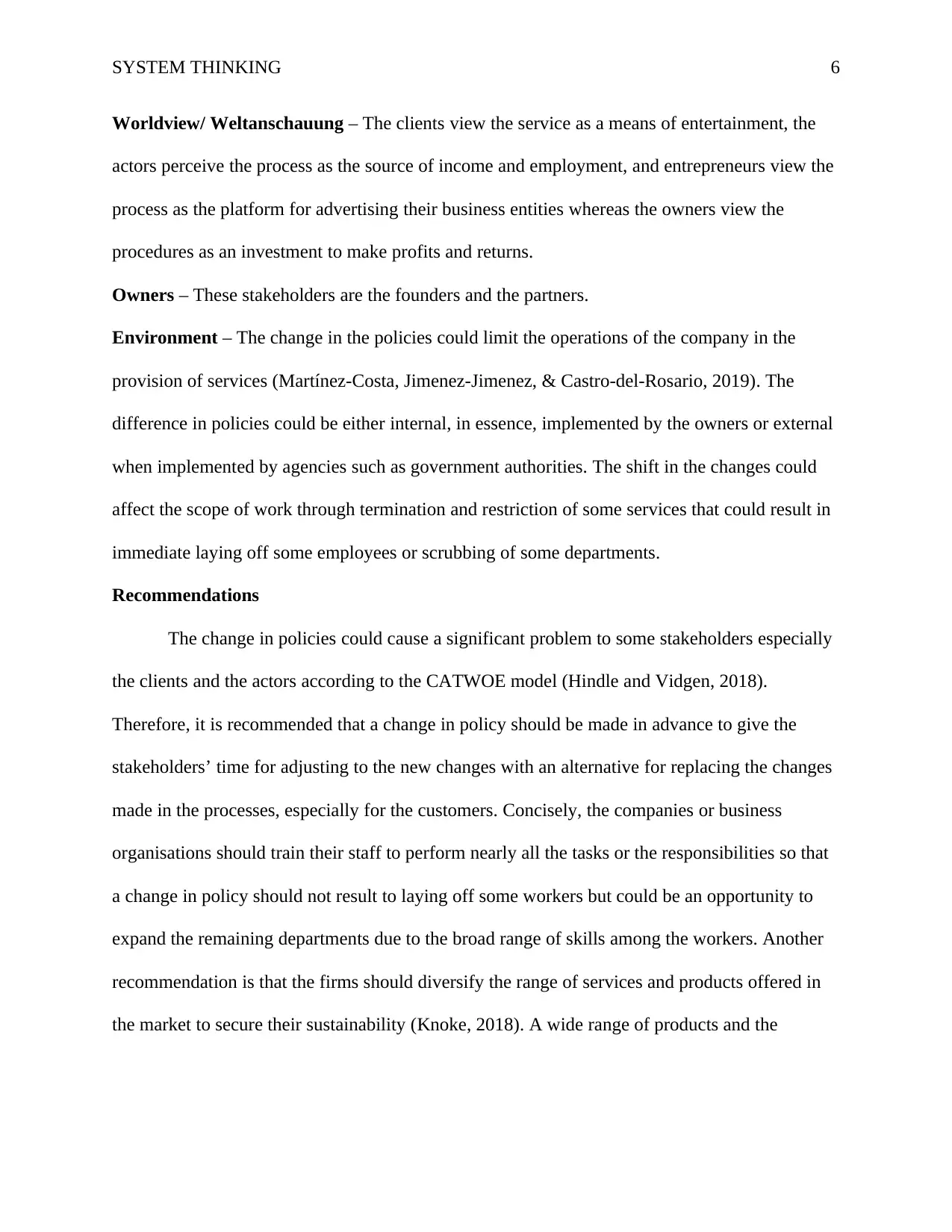
SYSTEM THINKING 6
Worldview/ Weltanschauung – The clients view the service as a means of entertainment, the
actors perceive the process as the source of income and employment, and entrepreneurs view the
process as the platform for advertising their business entities whereas the owners view the
procedures as an investment to make profits and returns.
Owners – These stakeholders are the founders and the partners.
Environment – The change in the policies could limit the operations of the company in the
provision of services (Martínez-Costa, Jimenez-Jimenez, & Castro-del-Rosario, 2019). The
difference in policies could be either internal, in essence, implemented by the owners or external
when implemented by agencies such as government authorities. The shift in the changes could
affect the scope of work through termination and restriction of some services that could result in
immediate laying off some employees or scrubbing of some departments.
Recommendations
The change in policies could cause a significant problem to some stakeholders especially
the clients and the actors according to the CATWOE model (Hindle and Vidgen, 2018).
Therefore, it is recommended that a change in policy should be made in advance to give the
stakeholders’ time for adjusting to the new changes with an alternative for replacing the changes
made in the processes, especially for the customers. Concisely, the companies or business
organisations should train their staff to perform nearly all the tasks or the responsibilities so that
a change in policy should not result to laying off some workers but could be an opportunity to
expand the remaining departments due to the broad range of skills among the workers. Another
recommendation is that the firms should diversify the range of services and products offered in
the market to secure their sustainability (Knoke, 2018). A wide range of products and the
Worldview/ Weltanschauung – The clients view the service as a means of entertainment, the
actors perceive the process as the source of income and employment, and entrepreneurs view the
process as the platform for advertising their business entities whereas the owners view the
procedures as an investment to make profits and returns.
Owners – These stakeholders are the founders and the partners.
Environment – The change in the policies could limit the operations of the company in the
provision of services (Martínez-Costa, Jimenez-Jimenez, & Castro-del-Rosario, 2019). The
difference in policies could be either internal, in essence, implemented by the owners or external
when implemented by agencies such as government authorities. The shift in the changes could
affect the scope of work through termination and restriction of some services that could result in
immediate laying off some employees or scrubbing of some departments.
Recommendations
The change in policies could cause a significant problem to some stakeholders especially
the clients and the actors according to the CATWOE model (Hindle and Vidgen, 2018).
Therefore, it is recommended that a change in policy should be made in advance to give the
stakeholders’ time for adjusting to the new changes with an alternative for replacing the changes
made in the processes, especially for the customers. Concisely, the companies or business
organisations should train their staff to perform nearly all the tasks or the responsibilities so that
a change in policy should not result to laying off some workers but could be an opportunity to
expand the remaining departments due to the broad range of skills among the workers. Another
recommendation is that the firms should diversify the range of services and products offered in
the market to secure their sustainability (Knoke, 2018). A wide range of products and the
⊘ This is a preview!⊘
Do you want full access?
Subscribe today to unlock all pages.

Trusted by 1+ million students worldwide
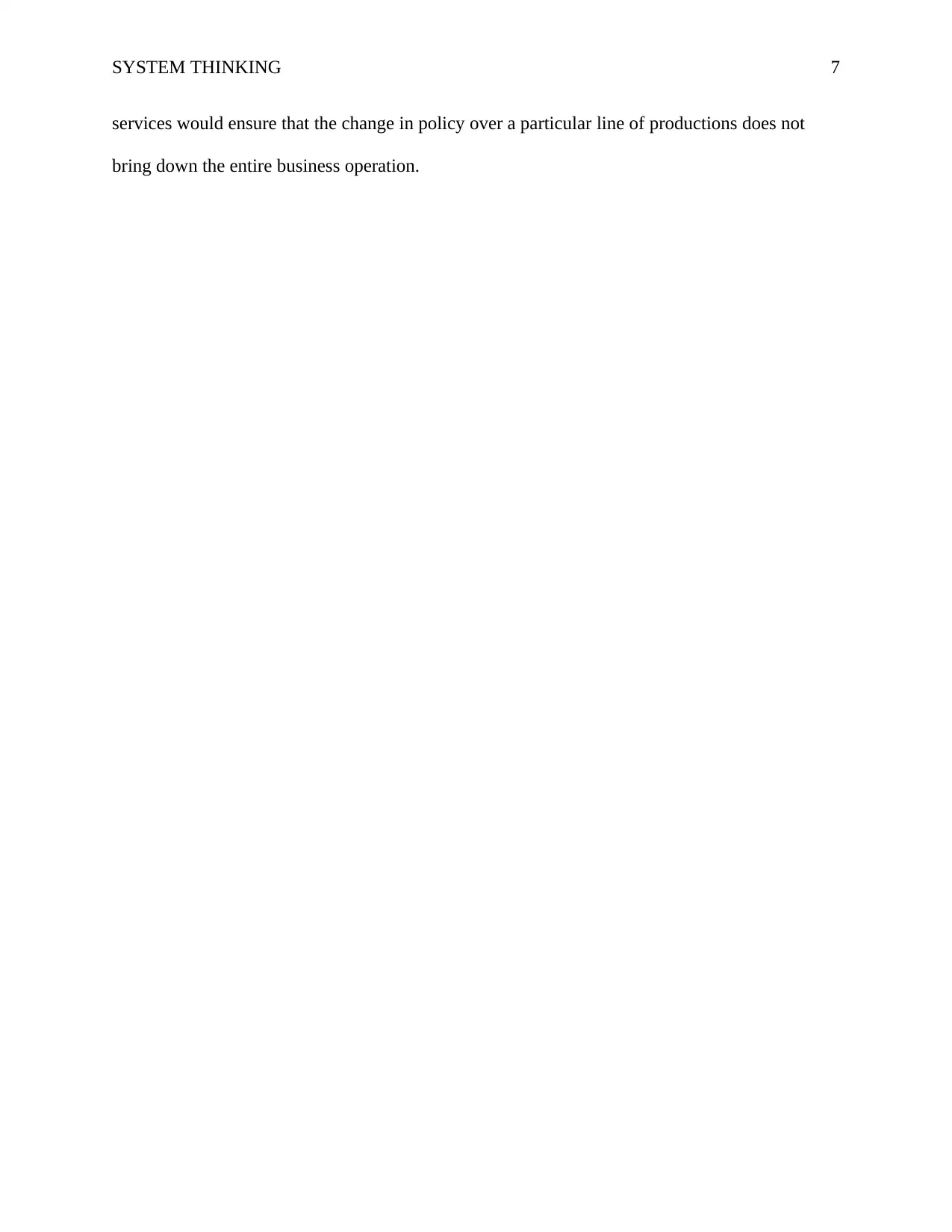
SYSTEM THINKING 7
services would ensure that the change in policy over a particular line of productions does not
bring down the entire business operation.
services would ensure that the change in policy over a particular line of productions does not
bring down the entire business operation.
Paraphrase This Document
Need a fresh take? Get an instant paraphrase of this document with our AI Paraphraser
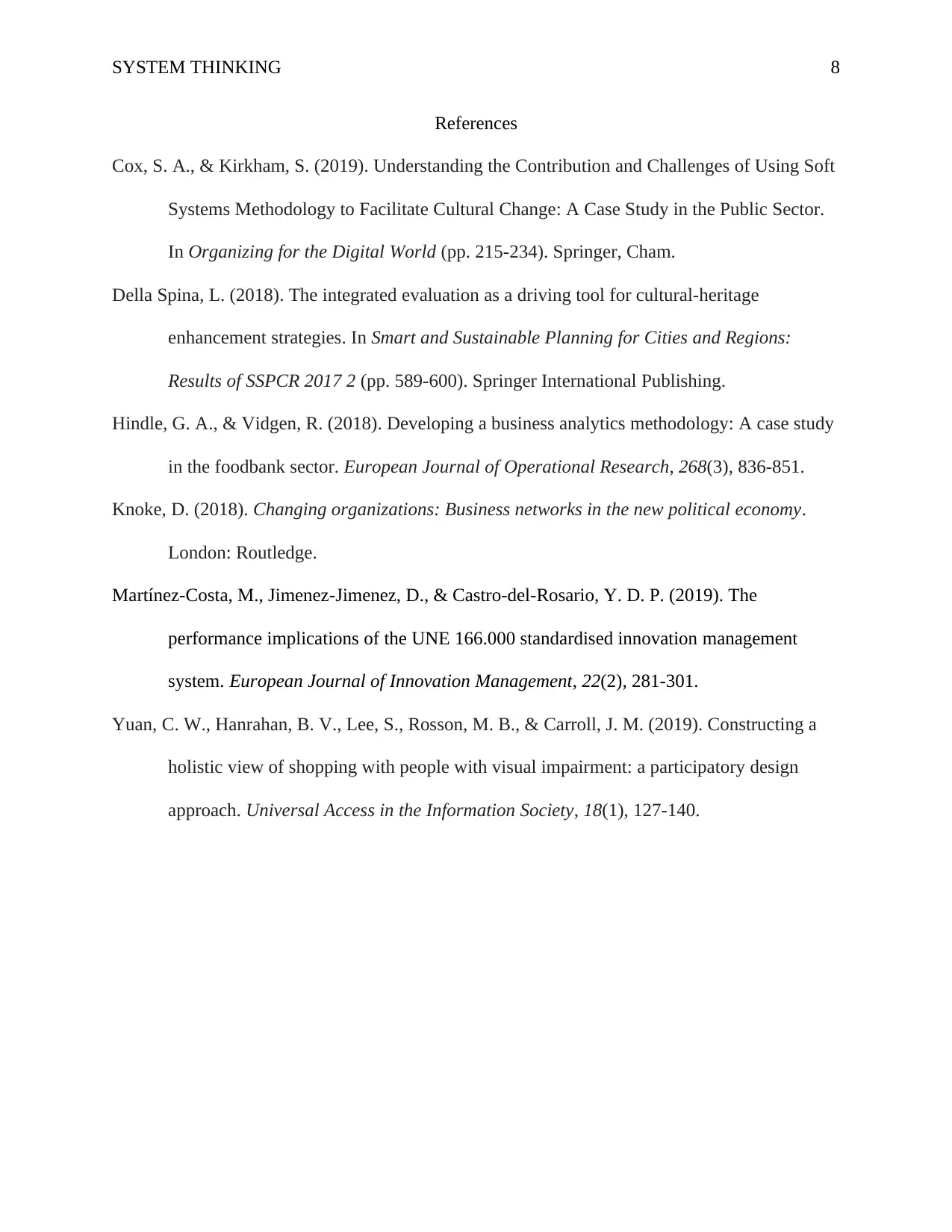
SYSTEM THINKING 8
References
Cox, S. A., & Kirkham, S. (2019). Understanding the Contribution and Challenges of Using Soft
Systems Methodology to Facilitate Cultural Change: A Case Study in the Public Sector.
In Organizing for the Digital World (pp. 215-234). Springer, Cham.
Della Spina, L. (2018). The integrated evaluation as a driving tool for cultural-heritage
enhancement strategies. In Smart and Sustainable Planning for Cities and Regions:
Results of SSPCR 2017 2 (pp. 589-600). Springer International Publishing.
Hindle, G. A., & Vidgen, R. (2018). Developing a business analytics methodology: A case study
in the foodbank sector. European Journal of Operational Research, 268(3), 836-851.
Knoke, D. (2018). Changing organizations: Business networks in the new political economy.
London: Routledge.
Martínez-Costa, M., Jimenez-Jimenez, D., & Castro-del-Rosario, Y. D. P. (2019). The
performance implications of the UNE 166.000 standardised innovation management
system. European Journal of Innovation Management, 22(2), 281-301.
Yuan, C. W., Hanrahan, B. V., Lee, S., Rosson, M. B., & Carroll, J. M. (2019). Constructing a
holistic view of shopping with people with visual impairment: a participatory design
approach. Universal Access in the Information Society, 18(1), 127-140.
References
Cox, S. A., & Kirkham, S. (2019). Understanding the Contribution and Challenges of Using Soft
Systems Methodology to Facilitate Cultural Change: A Case Study in the Public Sector.
In Organizing for the Digital World (pp. 215-234). Springer, Cham.
Della Spina, L. (2018). The integrated evaluation as a driving tool for cultural-heritage
enhancement strategies. In Smart and Sustainable Planning for Cities and Regions:
Results of SSPCR 2017 2 (pp. 589-600). Springer International Publishing.
Hindle, G. A., & Vidgen, R. (2018). Developing a business analytics methodology: A case study
in the foodbank sector. European Journal of Operational Research, 268(3), 836-851.
Knoke, D. (2018). Changing organizations: Business networks in the new political economy.
London: Routledge.
Martínez-Costa, M., Jimenez-Jimenez, D., & Castro-del-Rosario, Y. D. P. (2019). The
performance implications of the UNE 166.000 standardised innovation management
system. European Journal of Innovation Management, 22(2), 281-301.
Yuan, C. W., Hanrahan, B. V., Lee, S., Rosson, M. B., & Carroll, J. M. (2019). Constructing a
holistic view of shopping with people with visual impairment: a participatory design
approach. Universal Access in the Information Society, 18(1), 127-140.
1 out of 8
Related Documents
Your All-in-One AI-Powered Toolkit for Academic Success.
+13062052269
info@desklib.com
Available 24*7 on WhatsApp / Email
![[object Object]](/_next/static/media/star-bottom.7253800d.svg)
Unlock your academic potential
Copyright © 2020–2025 A2Z Services. All Rights Reserved. Developed and managed by ZUCOL.





